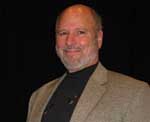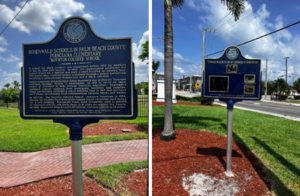
BOYNTON BEACH, Florida — Every Julius Rosenwald marker has a backstory. The Rosenwald marker story in Boynton Beach had a shocking twist.
The Jewish American Society for Historic Preservation (JASHP) recently donated and dedicated with its partners, the Boynton Beach Historical Society and the Boynton Beach Historic Resources Preservation Board, its newest Julius Rosenwald historical marker. The two-sided marker has text on one side and images on the reverse side. The text is as follows:
 “A school for black children was established before 1900 by members of the St. Paul AME Church. In 1907, the congregation petitioned the Dade County School Board for a teacher and built a small building on donated land. The school received its most significant assistance through a unique partnership involving a philanthropic businessman and a black educator.
“A school for black children was established before 1900 by members of the St. Paul AME Church. In 1907, the congregation petitioned the Dade County School Board for a teacher and built a small building on donated land. The school received its most significant assistance through a unique partnership involving a philanthropic businessman and a black educator.
Jewish-American philanthropist Julius Rosenwald was invited by Tuskegee Institute founder, Booker T. Washington, in 1912 to serve on their board of directors to help African American education. Segregated southern schools suffered from inadequate facilities and supplies. Their partnership initiated a school building fund in 1917 that provided seed money encouraging local collaborations between blacks and whites.
In 1925-26, the Boynton Colored School, renamed Poinciana in 1954, became the County’s first Rosenwald-funded school receiving seed money for a new building. Following the 1928 hurricane, Rosenwald funds were used to rebuild or construct schools and trade shops in 11 cities throughout the County. By 1932, Rosenwald helped fund 5,357 African American schools in 15 states.”
The marker was dedicated in the Sara Sims and Heritage Park of Boynton Beach. The park is within the boundaries of the historical Black Boynton residential area. The public, the mayor, and the city commissioner were in attendance.
Nearly 100 years ago, on February 5, 1924, the tiny agricultural town of Boynton passed an Ordinance with profound intent.
Ordinance No. 37
An Ordinance of the Town of Boynton, Florida, establishing and setting apart in said Town separate residential limits or districts for white and negro residents; designating, establishing and setting apart the territorial limits or district of said Town within which white persons may reside and separate territorial limits or districts in said Town within which negroes may reside…providing penalties for violations of this ordinance.
BE IT ORDAINED BY THE TOWN COMMISSION OF THE TOWN OF BOYNTON, FLORIDA
That said town does hereby establish and set apart the land within the following described limits in the town of Boynton to be hereafter known as the “Negro District within the Town of Boynton, Florida,’ to-wit:…”
Boynton was incorporated in 1920. The town and its surrounding farmland were literally carved from the scrub pine of the area. Beginning in 1896, settlers, White and Black, began moving to the area to produce fruits and vegetables.
That same year Boynton requested funding from the county for a White school. Education for Blacks children was not a serious consideration for the local White citizenry. Blacks too, sincerely wished the benefits of education for their children but were forced to largely rely on their own meager resources. Four years after the White population had a school, the first, very modest, Black school was organized in 1900, housed in the A.M.E. church. In 1907, a one room, one teacher, Black school was built.
Societal interactions between Whites and Blacks reflected the racist social norms of the period.
Supporting Black education was not without its risks. In 1910 Cullen Pence, a White Boynton developer, challenged the railroad and commercial interests. He was found dead in his Boynton home one Sunday after church. Pence was in his 30s, married with a young family, and prosperous. He was also a strong supporter of Black education in Boynton.
Pence’s death was ruled a suicide. The past president of the Boynton Beach Historical Society thinks that was highly unlikely. The shot to the upper rear of his head was physically impossible to make.
Death by suicide was the story the Palm Beach Post reported.
The Ku Klux Klan was rapidly rising to ascendancy across the U.S., not just in the South. Florida and Boynton were no exception.
By 1924, the city fathers felt the necessity of legalizing and mandating segregation for Boynton’s rising population.
Against this background, an incredible educational revolution was taking place.
The Rosenwald Fund was created because of the relationship of two very different men, Booker T. Washington, and Julius Rosenwald. Together, they transformed America.
Booker T. Washington was a Black man. He rose from slavery to become the President of Tuskegee Institute (University). Julius Rosenwald, the child of Jews who escaped the vicious antisemitism of Germany to seek opportunity in America, became the president of retailing giant Sears and Roebuck.
Washington showed Rosenwald the path. Rosenwald used his vast fortune to do what none had ever done before. The Rosenwald Fund was the catalyst to build over 5,300 schools, teachers’ homes, and industrial training shops, across 15 states of the South, for Black educational opportunities. By the 1930s, one-third of all Black American children attended a Rosenwald school.
Rosenwald provided the grant for the Boynton Beach Colored school in 1926, sited inside the newly created “negro ghetto” of Boynton. Two years later, the hurricane of 1928 killed over 3,000 people in Palm Beach County. It was able to destroy all the county schools except one, the Boynton Beach Colored School.
Rosenwald immediately went into action. He provided for the construction of 11 schools and Industrial shops across the county for the Black community.
The schools are gone today, replaced by 1973 when Palm Beach County’s educational system was officially declared desegregated.
JASHP’s Boynton marker donation is the only reminder of the past and the struggle for the future for all in Palm Beach County.
During the dedication, I shared a perspective few had ever heard before. It was a Jewish perspective shaped by the Holocaust.
My parents were survivors of Buchenwald and Bergen Belsen Concentration Camps. My mother came from a very wealthy family in Lodz, Poland.
One day my mother was wealthy. The day after the Nazis arrived, they were desperately poor. Their property, their land, their personal wealth was taken away. My family became slave labor.
There was one thing the Nazis could not take away. The Nazis could not take away their education. They survived and were able to begin again because of their education.
Ordinance 37, in Boynton, demonstrated that land, property, homes, could be taken away by racism, bigotry and hatred. The Rosenwald Boynton Beach Colored School kept open the door of freedom and possibility, no matter what the world of hate could do.
Jerry Klinger is the President of the Jewish American Society for Historic Preservation, www.JASHP.org